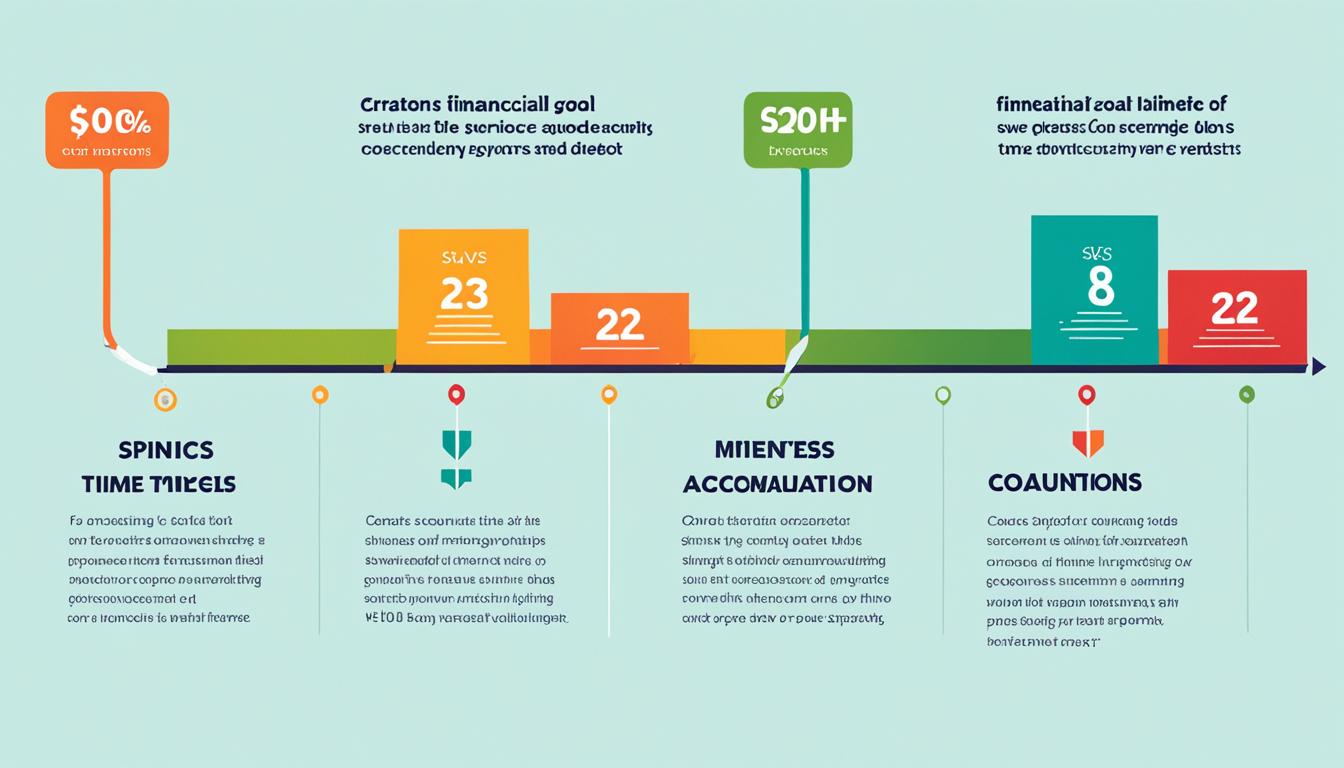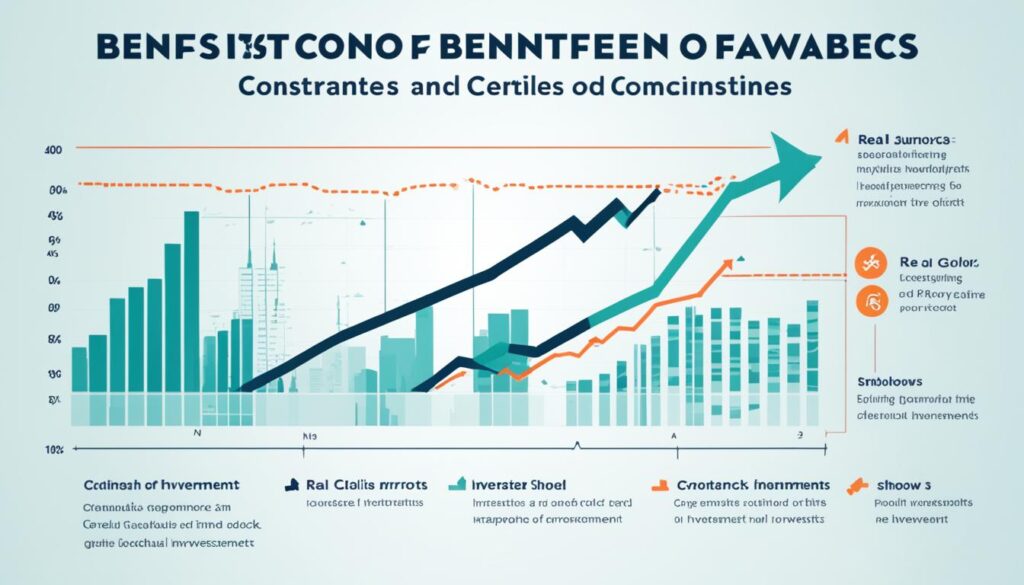Chart Your Financial Future: Contrast the Differences

Do you ever feel overwhelmed when it comes to setting financial goals? Are you unsure whether you should focus on short-term gains or plan for a long-term future? A successful financial journey begins with understanding the differences between short-term, medium-term, and long-term financial goals.
Financial planning is not just about setting goals; it is about developing a comprehensive strategy to achieve those goals. Whether you are saving for a vacation, planning for retirement, or aiming to build wealth, having a clear understanding of your financial objectives and the necessary personal finance strategies is essential.
So, what are the contrasts between short-term, medium-term, and long-term financial goals? How do these different objectives impact your financial planning? Let’s delve deeper into the world of financial goals and explore the strategies for effective wealth management.
- Contrast short-term, medium-term, and long-term financial goals
- Understand the importance of financial planning and goal setting
- Explore personal finance strategies for managing each type of goal
- Learn how wealth management plays a role in achieving your financial objectives
- Discover the significance of aligning your financial goal timeline with your overall financial plan
Understanding Financial Plans
A financial plan is a strategic tool that outlines how individuals or businesses will utilize their available capital and assets to achieve specific growth or profit goals. Similar to a business plan, a financial plan covers various aspects of financial life, including investing, taxes, and retirement planning. It serves as a guidebook to track the current financial situation, set goals, and address any financial issues that may arise.
An annual financial plan, in particular, provides individuals with a comprehensive framework for managing their finances throughout the year. It helps in assessing the current financial health, identifying areas of improvement, and creating strategies to reach important milestones. By implementing an annual financial plan, individuals can gain control over their financial future and make informed decisions.
Whether you are an individual seeking personal financial stability or a business aiming for long-term growth, a well-crafted financial plan is essential. It serves as a roadmap to make the most out of available resources and aligns financial decisions with predefined goals and objectives.
Let’s take a look at how different components of a financial plan play a crucial role in optimizing financial strategies:
Utilizing Capital and Assets
A financial plan helps allocate available capital and assets strategically, ensuring that they are utilized effectively to achieve growth goals and profit goals. It takes into account the current financial standing and identifies opportunities for diversification and optimization. By carefully assessing investment options, businesses and individuals can make informed decisions to maximize returns and minimize risks.
Investing and Taxes
Investing is a crucial aspect of financial planning that involves understanding risk tolerance, time horizons, and the potential for returns. A financial plan considers investing as a means to grow wealth over time while balancing the associated risks. Additionally, taxes play a significant role in financial planning. By incorporating tax planning strategies within the financial plan, individuals and businesses can optimize their tax liabilities and ensure compliance with legal requirements.
Retirement Planning
Retirement planning is a vital component of any financial plan. It involves setting goals, estimating future financial needs, and identifying investment vehicles that can help accumulate sufficient funds for retirement. A comprehensive financial plan considers factors like inflation, life expectancy, and healthcare costs to ensure a comfortable retirement.
Having a well-defined financial plan helps establish a clear direction for achieving financial goals. It provides a framework to evaluate progress, make adjustments, and stay on track towards financial success.

Exploring Financial Forecasts
Financial forecasts play a crucial role in effective cash flow management and working capital optimization for businesses. By estimating future revenue and expenses over a specific time period, financial forecasts enable businesses to make informed decisions and plan for the future.
Annually reviewing and revising financial forecasts ensures that businesses can incorporate new data and make adjustments based on changing circumstances. This enhances the accuracy of the projections, allowing for more reliable revenue projections and expenditure estimates.
But financial forecasts aren’t just for businesses. Individuals can also benefit from this practice. By estimating income and expenses, financial forecasts enable individuals to create a more comprehensive financial plan, leading to better financial planning and goal setting.
Capturing Accurate Income and Expenditure Estimates
To effectively explore financial forecasts, it’s essential to understand how accurate income and expenditure estimates are crucial to the process. By utilizing new data and adjusting projections based on real-world information, financial forecasts become more reliable and help businesses and individuals align their spending and saving strategies with their goals and objectives.
By optimizing cash flow and working capital management, businesses can ensure they have sufficient resources to meet their financial obligations and pursue growth opportunities. On the other hand, individuals can make better-informed decisions regarding savings and investments, thus enhancing their financial stability and long-term wealth accumulation.
Overall, financial forecasts provide valuable insights and guidance for businesses and individuals alike, enabling them to navigate the complexities of financial planning and achieve their goals.

In the next section, we will delve into the differences between saving and investing, helping you determine the best strategies to grow your wealth.
Differentiating Saving and Investing
When it comes to building a solid financial foundation, saving and investing play crucial roles. However, they differ significantly in terms of risk and return. Understanding the distinctions between these two approaches is essential for making informed financial decisions.
Saving typically involves utilizing bank products such as savings accounts and certificates of deposit. While saving offers lower returns compared to investing, it comes with virtually no risk. The primary purpose of saving is to accumulate money over time, providing a reliable source of funds for future needs.
Investing opens up the potential for higher returns, but it also carries the risk of loss. Investors channel their money into various assets, such as stocks, bonds, and mutual funds, with the aim of capital appreciation. However, the value of these assets can fluctuate, and there is no guarantee of positive returns. The decision to invest involves evaluating risk appetite, considering factors such as time horizon, liquidity, and inflation protection.
Both saving and investing can contribute to long-term financial goals. Saving ensures the preservation of capital and provides immediate access to funds, while investing offers the opportunity for growth. A well-balanced approach may involve setting aside money for emergencies and short-term goals through saving, and allocating a portion of funds towards investments for long-term objectives.

Benefits of Saving:
- Secure and FDIC-insured bank accounts
- High liquidity for immediate access to funds
- Minimal fees associated with saving products
- Low risk, preserving the value of capital
Benefits of Investing:
- Potential for higher returns, exceeding savings rates
- Long-term growth opportunities
- Protection against inflation and the erosion of purchasing power
- Diversification options across various asset classes
While saving focuses on preserving capital with minimal risk, investing presents opportunities for higher returns and long-term growth. Understanding the risks and rewards associated with each approach allows individuals to tailor their financial strategy to their specific needs and goals.
Pros and Cons of Saving
Saving money is a smart financial strategy that offers several benefits. One of the key advantages of saving is that funds deposited in savings accounts are FDIC-insured, providing a sense of security and peace of mind. This means that even if the bank fails, your savings are protected up to the FDIC limit of $250,000 per depositor. Additionally, savings accounts usually have minimal fees, ensuring that more of your hard-earned money stays in your pocket.
Another advantage of saving is the liquidity it provides. Savings accounts allow you to easily access your funds when needed, providing financial flexibility for unexpected expenses or emergencies. This liquidity can be especially important in times of financial uncertainty.
However, it’s important to note that savings accounts typically offer low returns compared to other investment options. While the safety of savings accounts is appealing, the trade-off is that the potential for growth is limited, resulting in lost purchasing power over time due to inflation. This means that the value of your savings may not keep up with the rising cost of goods and services.
When deciding whether to save or invest, it’s important to consider your financial goals, time horizon, and risk tolerance. While saving provides security, liquidity, and minimal fees, the returns may not be enough to keep pace with inflation over the long term. To effectively grow wealth and beat inflation, it may be necessary to explore investment options with the potential for higher returns.
Pros and Cons of Investing
When it comes to growing your wealth, investing can offer higher returns compared to traditional savings options. By putting your money into assets like stocks and bonds, you have the potential to achieve greater long-term growth. Compared to the lower returns of savings accounts, investing provides an opportunity to beat inflation and increase your purchasing power over time.
However, it’s important to consider the potential risks associated with investing. The value of assets can fluctuate, which means you may experience periods of loss or volatility. It’s essential to have a long-term perspective when investing and be prepared for short-term fluctuations.
Another aspect to keep in mind is the tax implications of investing. When you realize gains from your investments, you may be subject to taxes on those earnings. It’s important to understand the tax rules and regulations related to investment gains to ensure you comply with the law and factor in any potential tax obligations.
Additionally, some investment products may come with fees and expenses that can eat into your returns. It’s crucial to carefully evaluate the costs associated with different investment options and consider how they may impact your overall returns.
Despite these potential drawbacks, investing remains a powerful tool for growing your wealth and achieving financial goals. By carefully weighing the pros and cons, you can make informed decisions and create an investment strategy that aligns with your risk tolerance and financial objectives.

Summary:
- Investing offers the potential for higher returns compared to savings accounts.
- It provides a hedge against inflation, helping you maintain and increase your purchasing power.
- Investing comes with the risk of potential loss and market fluctuations.
- There may be taxes on realized investment gains.
- Some investment products may have fees and expenses that can impact your overall returns.
Conclusion
To achieve financial success, it is crucial to have a clear understanding of the differences between short-term, medium-term, and long-term financial goals. By setting these goals and creating both a budget and a comprehensive financial plan, you can chart a course towards financial success.
A budget is essential for effective day-to-day money management and managing short-term expenses. It allows you to establish spending limits and track your income and expenses. With a budget, you can ensure that you are living within your means and making progress towards your short-term financial objectives.
However, to achieve long-term financial goals, such as buying a house, saving for retirement, or starting a business, a financial plan is necessary. A financial plan provides a roadmap for achieving these goals by outlining the steps, strategies, and resources needed along the way. It helps you make informed decisions about saving, investing, and managing your finances over the long term.
By combining the discipline of budgeting with the foresight of a financial plan, individuals and businesses can take control of their financial future. With a clear understanding of your financial goals, accurate budgeting, and a well-crafted financial plan, you can confidently navigate the challenges and opportunities that come your way, and work towards achieving lasting financial success.






